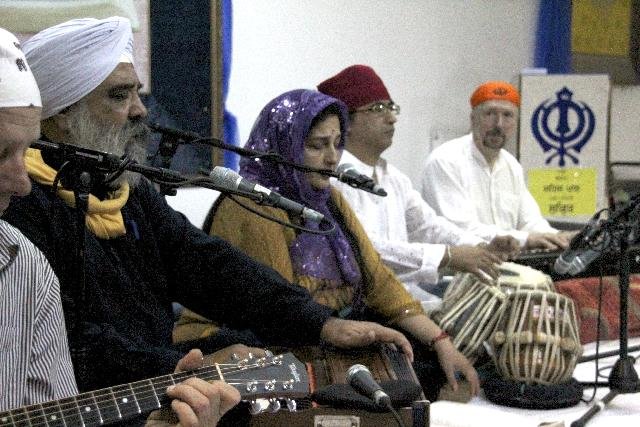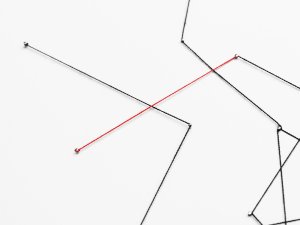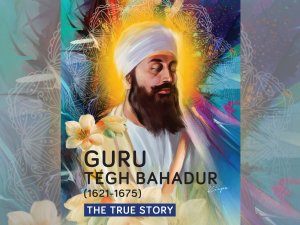Evolution of Indian & Sikh Classical Raag Tradition
There is a mistaken belief amongst Gurbani Keertan purists sometimes that Indian and Sikh classical raags have remained static over the centuries. Gurbani singers like Sikh “world music” genre pioneer, Dya Singh of Australia, are at the receiving end of criticism because they do not always stick to the beaten track of traditional Gurbani Keertan sung to prescribed raag bases.

Dya Singh’s distinctly Sikh “world music” (fusion music) mission and a milestone achievement in his forthcoming Gurbani album release “Dukh bhanjan Tera Naam” is discussed in another article. In that context, this item summarises the evolution of Indian and Sikh classical sangeet over the centuries to inform ongoing discussion under this thread.
Indian classical raag (raga)
Very few Indian raag (usage singular or plural - see below) have survived in their original form. In fact most Indian classical raag sung or played on musical instruments today, are a mixture of middle-eastern and ancient Indian music and were given their present form from the 13th century onwards. The name of Hazrat Amir Khusro, a courtier of Emperor Allaodin Khilji, is associated with the establishment of the Northern Indian School of music. The poet Lochan in the fifteenth century first introduced the concept ofthaat (literally means “harmony” or “combination” in Sanskrit). A southern Indian scholar, Pandat Vayankatmukhi, worked out mathematically that it was possible to have 72 thaat but even he used only 19 of these to classify raag. Finally in the 19th century, a great scholar of music Pandit Vishnu Narain Bhaatkhande selected only 10 thaats based on 12 notes (7 shudh and 5 komal/thibar) to classify Indian raag. This is the system in use throughout India today, although, many music schools continue to disagree with this modern classification.
The ancient system of classifying raag into families i.e. main raag and their derivative “wives and sons” described in the “Ragmala” in Sri Guru Granth Sahib (SGGS), has not been used for many centuries since the introduction of thaat. Many scholars of Indian music regard this as a great sacrilege and corruption of the ancient raag (Shastri sangeet); others see the change to the current (comparatively) much simpler system as a vehicle for making Indian classical music more popular and accessible. This change would be in the spirit of Gurbani keertan or sangeet.
What is a raag
Without going into the technicalities , a raag should be capable of capturing and enhancing the mood:
- of the time e.g. morning or evening etc;
- the season e.g. spring, monsoon etc.; or,
- an emotion e.g. joy, sorrow, longing, bravery, patriotism, peace, detachment, spiritual fulfilment etc.
Some believe that raag are endowed with soothing, healing, spiritual and even miraculous powers. For example, it was believed that Raag Megh sung meditatively in its pure form, could bring rain and Deepak could light lamps. The rules of raag were well defined but have changed over the centuries. So much so that many different ghranas (houses or schools of raag ) have emerged with their own versions of raag. Yet, the classical Indian music ear and heart will know when a raag is played or sung by a maestro. The rules of Indian classical music based on western 12 keys were redefined by Pundit Vishnu Narain Bhaatkhande in the 19th century. Before that Indian raags were based on 7- key notes further divided into 22 shrutee and arranged to certain musical note combinations used by ancient rishi musicians. In Indian raag parlance these systems were based on shrutee and moorshna.
Many prominent masters disagreed, and continue to disagree, with this change from shrutee- based division of the present day octave (division of keys between one “sa” and the next higher on the musical scale). Pundit Firoz Fraam (of Poona) and Pundit Vinaik Narain Patvardhan were prominent amongst the leading opponents who claimed that there was strong middle-eastern music influence (backed by the ruling Mughal preferences) behind this change. The harmonium or the piano and similar modern fixed key instruments are not accepted as proper musical instruments by these purists. Indeed some classical raagis (raag singers) refer to the harmonium derisively as “peti” (box), an instrument of beggars, for it was mostly used by street beggars in Europe and the Middle-east. (I took some satisfaction by pointing this out to a member of a hajoori raagi jatha of Darbar Sahib, who derided the variety of string instruments (taanti saaj) played by Dya Singh’s companions.)
Such controversies will remain and will continue to grow as Indian classical tradition is exposed to world music and international influences; and as Indian musicians respond to the rhythm and beat appreciated by western and westernised ears. Increasing use of east-west musical instruments is a part of this trend. Dya Singh music has used the western piano, guitar and violin to great effect.
What is Gurbani Kirtan ?
Gurbani kirtan or sangeet, is the singing of Gurbani, the Word of the Guru, in accordance with raag- based guidance given in Sri Guru Granth Sahib (SGGS), the holy Scripture of the Sikhs. The aim of Gurbani Kirtan is to enhance the impact of the Guru’s Word (Gurbani or Shabad) on the human soul (atma) and to harmonise it with the Universal Soul (Param Atma) by achieving a state of bliss (anand).
Kirtan is a form of meditative music (bhagti sangeet). The development of bhagti sangeet in India dates back to the evolution of religious thought and gained momentum with the progress of the bhagti movement in India from about 11th Century C.E. onwards. There is a long list of the bhagats (saints with Hindu or Muslim backgrounds preaching universal love of God) like Tulsi Das, Meera, Jaidev, Namdev, Shaikh Farid, Ravidas, Kabir etc who promotedbhagti sangeet. The next phase of bhagti sangeet was introduced by the Sikh Gurus starting with Guru Nanak Sahib (1469 to 1539 A.D.) as Gurbani keertan.
In an ancient Indian scripture, the Lord says “Where my bhagats sing my praises there I reside.” The Sikh Gurbani confirms “Tahan baikunt jeh kirtan Tera” (“Heaven is where Your praise is sung.”) Gurbani sangeet started when Guru Nanak said to his musician companion Mardana “Touch the string of your rabaab (rebeck) O’ Mardana, I am receiving Bani (the Divine Word)”.
Guru Nanak composed and sang Gurbani in 19 classical raag; Guru Amardas (Third Guru) in 17, Guru Ramdas (Fourth Guru) in 29 and Guru Arjan Dev (Fifth Guru) in 30 raag. There are altogether 31 shudh (pure) raag in SGGS and many further raag combinations and popular folk tunes.
Guru Nanak travelled extensively. He sang to the people outdoors, sitting under the shade of trees or in the open fields. He sang in many different languages and popular tunes (vaars and dhunees). He went out there and communicated with the ordinary people using the language and music which they understood and loved. Yet, he preserved the essential character of classical raag tradition as well and selected raag bases to enhance the spiritual message of Gurbani, the Guru's Word.
It may be argued that Dya Singh too is following in his Guru’s footsteps by taking Gurbani to world audiences in the world-musical language they relate to.
The main criterion for the raag bases selected by the Gurus was that Gurbani singing should enhance the spiritual message of Gurbani and induce a mood of meditation and spiritual equipoise (sehaj anand).
Some facts about Gurbani raag bases, folk tunes, beats and rhythms are as follows:
a) There are 31 main raag in Guru Granth Sahib.
b) In addition there are almost as many mixed raag, popular folk music called dhunee (rhythm and beat) used. The different types of vaars (songs about heroes, wars and popular love stories) are examples of these popular tunes. Some examples are:
- Tunde Asraje ki dhunee
- Malik Mureed tatha Chandra Sohian ki dhunee
- Rai Kamal Maujdi ki vaar ki dhunee
- Jodhe Vire Purbani ki dhunee
- Rai Mehme Hasne ki dhunee
- Lalla Behlima ki dhunee
- Raaney Kailash tatha Maaldey ki dhunee
c) Popular folk tunes include ghorian, satta, bir-harey and alahonian.
d) Guru Gobind Singh Ji composed Gurbani (in Dasam Granth which includes compositions of Guru Gobind Singh and some other Sikh poets) in popular raags, folk tunes, rhythms and beats. It is said that Guru Ji was an accomplished musician in 235 raags. Indeed, Dasam Granth reputedly includes poetry to the beat of ferangi taal ! Many years ago, during a discussion, I was amazed to hear elderly and well known Sikh scholar and raagi, Giani Nahar Singh, giving an example by playing this disco type of drum beat on the arms of a wooden chair, while singing a few lines of a composition from Dasam Granth to that beat.
e) The Sikh dhadis to this day sing martial songs of Sikh heroes and even Gurbani Shabads to music bases of popular vars and love stories e.g. those of Mirza, Heer etc.
f) Guru Nanak Sahib's music companion was Bhai Mardana, a Muslim. Some popular raagis of Darbar Sahib and other major Gurdwaras e.g. Bhai Chaand at Darbar Sahib and Bhai Laal at Nankana Sahib have been Muslim (response to those who sometimes, in their ignorance, do not allow non-Sikh musician companions of Dya Singh on Gurdwara stages.) Yet, there are good reasons why Sikh Reht Maryada allows keertan in Sangat by Sikhs only. There is no mention of non-Sikh musicians on gurdwara stage. It is heartening to see on Sikh TV channels , recordings of classical raagi, elderly Bhai Balbir Singh doing Asa ki Vaar accompanied by Sikh and non-Sikh taanti saaj (string instrument) players on gurdwara stage.
With few exceptions, most Gurbani is in classical raag and should preferably be sung to those raag bases. However, as we have seen above, any rigid application of this rule would go against the underlying spirit of Gurbani sangeet.
Raag bases and instrumental skills are aids to the globalisation of Sarab Sanjhi Bani received in many languages and musical traditions, which, as we have seen, continue to evolve. Let accomplished Gurbani sangeetkars follow in the footsteps of Guru Nanak Sahib and Bhai Mardana, and take the soothing and spiritual message of Gurbani to audiences worldwide.
Gurmukh Singh
Ret’d Principal (policy), UK Civil Service
E-mail: [email protected]
Sources:
In addition to own inherited knowledge of Gurbani Keertan, the following
publications in Punjabi have been my
constant companions for many years:
- Principal Dyal Singh: “Gurmat Sangeet Sagar” (4 Volumes) 1992, Guru Nanak Vidya Bhandaar Trust, New Delhi.
- Sant Sarwan Singh Gandharv: “Sur Simran Sangeet” (7 Volumes) 1990, Purabi Printing Press, Jalandhar.
- Bhai Sahibs Avtar Singh &; Gurcharan Singh “Gurbani Sangeet Praacheen Reet ratnaavli” (2 Volumes) 1979, Punjabi University, Patiala.






